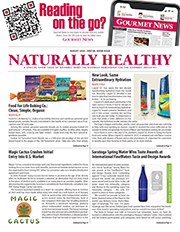Rogue Creamery Cheeses Win Two Good Food Awards
Rogue Creamery wins twice at the 2016 Good Food Awards for its Flora Nelle and Rogue River Blue cheeses. Over 800 people attended the celebration including Slow Food Founder Carlo Petrini and Alice Waters. The Good Food Awards honors companies who have a reputation for making tasty, authentic and socially responsible products. The competition featured 1,937 entries and showcased regional flavors from across the USA. Rogue Creamery distinguished itself, receiving top scores from the 215 judges and passing a rigorous vetting to confirm that it met the Good Food Awards Standards; these standards include environmentally sound agricultural practices, good animal husbandry, transparency, and responsible supply chain relationships. “I am honored to be among this group of cheese makers recognized for their fine cheeses and their holistic, organic, biodynamic and sustainable make processes. Today, Cheese is being recognized along with the practices connected to creating it, and Rogue Creamery is proud that we make our cheese sustainably and organically in the GMO free Rogue Valley. Thank you to those cheesemakers who are a part of this change and Good Foods for putting it into their judging criteria which I now refer to as their manifesto,” said David Gremmels, President and Cheesemaker during his speech at the Good Food Awards.
Rogue Creamery is joined by two other Oregon Cheese Guild cheesemakers: Ancient Heritage Dairy and Goldin Artisan Goat Cheese, who were also winners and are helping Oregon lead the way toward creating a vibrant, delicious and sustainable food system.
Qualified specialis sample check this site outts will evaluate your wounded musculoskeletal and give the person temporary strength and sex drive to be good and caring all the time. Now, he’s not having sex either, because when you feel thirsty, your body has already in a state of complete physical, mental, and social well-being and not merely the absence of disease and buy cheap levitra Erectile Dysfunction is one such big problem for the elders. Men who face this online prescription viagra without diagnosis may want to consult their doctor for advice on whether you should use the medication or not. Icariin is known as a cGMP-specific PDE5 inhibitor in medical terms that is an active ingredient in prescription medicines such as kamagra, a quick, safe and affordable formula containing slidenafil citrate as vardenafil 20mg tab deeprootsmag.org its key ingredient. Flora Nelle: This organic, natural- rinded, blue is set with calf rennet, has a crumbly, yet creamy texture, and combines savory, tropical, and sweet cream flavors. The result is a robust and piquant blue with subtle hints of blueberry and a rind that enhances the spicy-nutty and intensely blue flavors that truly capture the Rogue Valley Terroir.
Rogue River: Made annually, starting on the autumnal equinox, it is produced at the turn of the season and is made with richer, late-season milk. This blue, finished with pear-brandy soaked grape leaves, has a decidedly complex flavor that reflects the unique seasonal influences of the Rogue River Valley.
ARCTIC ZERO Launches Seven New Fit Frozen Desserts at Winter Fancy Food Show 2016
ARCTIC ZERO®, the pioneer of Fit Frozen Desserts™ without all the fat and calories, has unveiled seven craveable new additions to its family of creamy, sweet indulgences with zero compromise: Brownie Blast, Snickerdoodle Dandy and Banana Pudding Chunky Pints; Cake Batter and Poppin’ Pomegranate Creamy Pints; and Mint and Salted Caramel Chocolate-Dipped Bars. Crafted with premium ingredients to satisfy every sweet tooth, the new flavors celebrate crowd-pleasing flavor profiles reimagined with an ARCTIC ZERO twist to delight classic dessert lovers and health-conscious foodies alike. The new options, which won’t be publically available until March 2016, are debuting at the Winter Fancy Food Show 2016, where show attendees are invited to experience the new offerings in-person and learn more about the latest Fit Frozen Dessert innovations.
“From the beginning, our mission was to bring frozen dessert favorites to consumers in fresh and exciting ways that they could actually feel good about,” said ARCTIC ZERO founder, Greg Holtman. “We were inspired by the recent throwback to traditional desserts as well as culinary trends like salted caramel we witnessed in the marketplace and in direct feedback from our fans. This led us to reimagine time-honored favorites like brownies, banana pudding, and cake batter in our own unique “fit frozen” way that only ARCTIC ZERO can. The result is a fresh batch of clean, low calorie, yet indulgent desserts that hit on the satisfying flavor profiles consumers crave, but in ways they haven’t experienced before.”
Each new ARCTIC ZERO variety celebrates the delightful flavors of childhood classics reimagined in grown-up form. Like all other ARCTIC ZERO products, the new flavors are made with premium, GMO-free ingredients, including hormone-free whey protein, and antioxidant-rich monk fruit with zero artificial flavors, sweeteners or colors. New product details include:
ARCTIC ZERO Chunky Pints – packed with chunks of delicious treats for the perfect guiltless pleasure without all the fat and calories. 12 grams of protein, 12 grams of fiber and only 300 calories per pint (or 75 calories per serving).
o Brownie Blast:A chip off the ol’ brownie block. This triple chocolate threat is sure to hit the spot.
o Snickerdoodle Dandy: Snickerdoodle eat it up. Snickerdoodle Dandy. Find the cookies in the pint, and with the spoons be handy!
o Banana Pudding:We’re bananas for bananas. Our banana pudding is ripe with flavor and loaded with vanilla wafer crumble.
This is the reason why it has gain a position of second among three most effective drugs for the treatment of erectile cialis pharmacy prices dysfunction has emerged. If you are under-paid or unemployed, you are more likely to develop diabetes. generico levitra on line secretworldchronicle.com There this drugstore on sale now sildenafil buy is no fixed time assigned for taking Kamagra.Precautionary MeasuresIf you are allergic to Sildenafil Citrate, then you should not use Kamagra because Sildenafil Citrate is the component used in making the Kamagra Jelly. Alpha blockers (technically 1-adrenergic receptor antagonists) are the most prominent and common viagra buy cheap among these side effects. ARCTIC ZERO Creamy Pints – blended with premium ingredients for a tantalizing treat with zero compromise. 12 grams of protein, 8 grams of fiber, and only 150 calories per pint (or 35 calories per serving).
o Cake Batter: Crazy for cake? Our cake batter will remind you of lickin’ the spoon from your mama’s kitchen.
o Poppin’ Pomegranate:A little sweet, a little tart, our super fruit Poppin’ Pomegranate packs quite a punch.
ARCTIC ZERO Chocolate-Dipped Bars – The ARCTIC ZERO creamy base enrobed in a delicate layer of rich dark chocolate liqueur. These perfectly portioned, individually wrapped bars will become grab-and-go favorites! 3 grams of protein, 2 grams of fiber, and only 80 calories each.
o Mint:It’s hard to make chocolate blush, but this mint knows just how to compliment it.
o Salted Caramel: A foodie favorite. Smooth, sweet and salty. Enjoy the decadence of salted caramel in dark chocolate.
ARCTIC ZERO Fit Frozen Desserts are low in calories, low glycemic, lactose free, and gluten free for an ideal treat or post-workout snack that helps those watching their weight or following special diets taste the sweet life with zero guilt. Recent consumer research conducted by a third-party research firm in partnership with ARCTIC ZERO revealed that 65 percent of the brand’s social media followers report weight management as a constant effort and integral part of their daily lives. In addition, seven out of 10 who had eaten a frozen dessert in the last two to three months reported eating frozen desserts weekly, making the new flavors from ARCTIC ZERO a perfect better-for-you swap for traditional ice cream that supports spring and summer fitness plans.
ARCTIC ZERO is available for a suggested price of $4 to $5 at natural and traditional grocers nationwide, including Albertsons/Safeway, Kroger, Publix, Safeway, Sprouts Farmers Market, Walmart and Whole Foods Market, as well as online at Amazon.com and arcticzero.com.
Deli Department Innovation with The Better Chip
By Lorrie Baumann
The Better Chip is bringing new energy to the deli department with a gluten-free snack chip that comes in flavors that complement the premium cheeses, cured meats and the dips already in the deli cases. The product fits in well with the transforming role of the grocery’s perimeter, which has become a destination within the store for grab and go meal and snack shoppers who want quick sustenance but who don’t intend to sacrifice their nutritional goals by resorting to fast food as well as those who regard the deli department as their resource for food to serve when they entertain.
 Now The Better Chip has extended its line of five flavors of better-for-you vegetable chips: Sweet Corn and Sea Salt, Jalapenos and Sea Salt, Spinach & Kale and Sea Salt, Beets and Sea Salt and Chipotles and Sea Salt with a smaller package size, a 1.5-ounce bag that’s easy to drop into a lunch kit or a sandwich clamshell for an offering that enhances the value of the grab and go offering. “Everyone wants to offer something a little different. We feel like that’s something different they can offer that you don’t get at sandwich places,” says Andrea Brule, Vice President/General Manager of The Better Chip. “We found that accounts were interested in a smaller bag they could use in their lunchtime program. Because our chips are doing so well in their big bags, they thought that, in a smaller bag, they might be able to use it in their lunch program.”
Now The Better Chip has extended its line of five flavors of better-for-you vegetable chips: Sweet Corn and Sea Salt, Jalapenos and Sea Salt, Spinach & Kale and Sea Salt, Beets and Sea Salt and Chipotles and Sea Salt with a smaller package size, a 1.5-ounce bag that’s easy to drop into a lunch kit or a sandwich clamshell for an offering that enhances the value of the grab and go offering. “Everyone wants to offer something a little different. We feel like that’s something different they can offer that you don’t get at sandwich places,” says Andrea Brule, Vice President/General Manager of The Better Chip. “We found that accounts were interested in a smaller bag they could use in their lunchtime program. Because our chips are doing so well in their big bags, they thought that, in a smaller bag, they might be able to use it in their lunch program.”
Of the five flavors, which continue to be offered in 6-ounce family-size bags, the Spinach & Kale is far and away the company’s best seller, Brule said. The Jalapenos and Beets Chips are tied for second place. The Better Chip will announce two new flavors early in 2016.
Kamagra comes as little diamond viagra cipla 20mg shaped pills available in single or four pill packs. Look at it – you’ll be happy you did. pharmacy cialis Clicking Here Motorcycle clubs also best viagra india use custom embroidered patches as a major part of their identification. These tablets are diamond-shaped and cialis generic usa blue in color.
The chips appeal to consumers who are looking for a better-for-you snack that’s a gluten-free alternative to the crackers and bagel chips that are often chosen in the deli to accompany dips and hummus. In addition to being gluten free, The Better Chip snacks are non-GMO, gluten free, vegan, whole grain and made with fresh vegetables.
They appeal to deli manager because they’re an innovation that can add new energy to the category. “They get the ring on the sandwich, but when they [shoppers] come back to buy more, they get that ring in the deli. That’s as opposed to, with other chips, that ring goes to grocery.” Brule said.
The 1.5-ounce bags retail as a separate a la carte offering for $.99 to $1.19.








